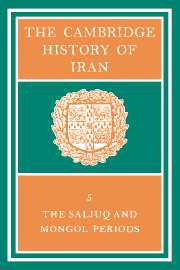Book contents
- Frontmatter
- 1 THE POLITICAL AND DYNASTIC HISTORY OF THE IRANIAN WORLD (A.D. 1000–1217)
- 2 THE INTERNAL STRUCTURE OF THE SALJUQ EMPIRE
- 3 RELIGION IN THE SALJUQ PERIOD
- 4 DYNASTIC AND POLITICAL HISTORY OF THE IL-KHĀNS
- 5 THE ISMĀ‘ĪLĪ STATE
- 6 THE SOCIO-ECONOMIC CONDITION OF IRAN UNDER THE ĪL-KHĀNS
- 7 RELIGION UNDER THE MONGOLS
- 8 POETS AND PROSE WRITERS OF THE LATE SALJUQ AND MONGOL PERIODS
- 9 THE VISUAL ARTS, 1050–1350
- 10 THE EXACT SCIENCES IN IRAN UNDER THE SALJUQS AND MONGOLS
- Bibliography
- Index
- Plate section
- References
6 - THE SOCIO-ECONOMIC CONDITION OF IRAN UNDER THE ĪL-KHĀNS
Published online by Cambridge University Press: 28 March 2008
- Frontmatter
- 1 THE POLITICAL AND DYNASTIC HISTORY OF THE IRANIAN WORLD (A.D. 1000–1217)
- 2 THE INTERNAL STRUCTURE OF THE SALJUQ EMPIRE
- 3 RELIGION IN THE SALJUQ PERIOD
- 4 DYNASTIC AND POLITICAL HISTORY OF THE IL-KHĀNS
- 5 THE ISMĀ‘ĪLĪ STATE
- 6 THE SOCIO-ECONOMIC CONDITION OF IRAN UNDER THE ĪL-KHĀNS
- 7 RELIGION UNDER THE MONGOLS
- 8 POETS AND PROSE WRITERS OF THE LATE SALJUQ AND MONGOL PERIODS
- 9 THE VISUAL ARTS, 1050–1350
- 10 THE EXACT SCIENCES IN IRAN UNDER THE SALJUQS AND MONGOLS
- Bibliography
- Index
- Plate section
- References
Summary
We can distinguish the following periods in the socio-economic history of Iran during the Mongol dominion.
The first period—from the twenties to the nineties of the thirteenth century—is marked by the colossal economic decline of Iran, caused both by the devastation wrought during the Mongol conquest, and still more by the administrative practices, in particular the taxation policy, of the first conquerors (the viceroys of the Great Khan, and then from 1256 the Īl-Khāns). Typical phenomena of the time are a reduction in population and cultivated land, the decline of agriculture, the migration of fresh multitudes of Mongol and Turkish nomads, and the expansion of migrational cattle-breeding, a decline in urban life, the growth of tendencies of natural economy, an increase in state taxes and feudal rent, the attachment of peasants to the soil, and the growth of a peasant insurrectionary movement.
The second period—from the nineties of the thirteenth century to the middle thirties of the fourteenth century (to the death of Īl-Khān Abū Sa‘īd in November 1335) is characterized by something of an economic upsurge, especially in agriculture, as a result of the reforms of Ghazan. During this and the following periods conditional private ownership of land and large-scale unconditional landownership expanded at the expense of state and small-scale peasant landowning. The economy of the country did not however attain its pre-1220 level.
The third period extends from the mid-Timur's conquest). This period is marked by feudal dismemberment, the struggle for power of feudel groups, and the political disintegration of the Ī-Khānid state as a result.
- Type
- Chapter
- Information
- The Cambridge History of Iran , pp. 483 - 537Publisher: Cambridge University PressPrint publication year: 1968
References
- 23
- Cited by

